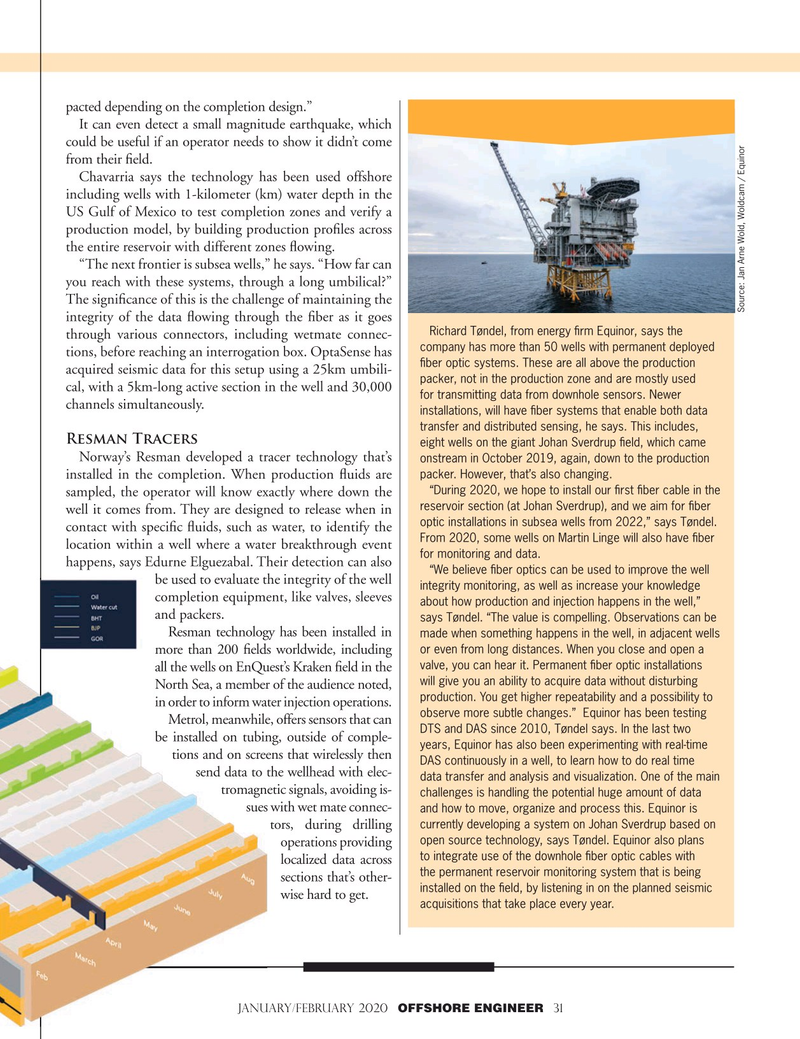
Page 31: of Offshore Engineer Magazine (Jan/Feb 2020)
Read this page in Pdf, Flash or Html5 edition of Jan/Feb 2020 Offshore Engineer Magazine
pacted depending on the completion design.”
It can even detect a small magnitude earthquake, which could be useful if an operator needs to show it didn’t come from their ? eld.
Chavarria says the technology has been used offshore including wells with 1-kilometer (km) water depth in the
US Gulf of Mexico to test completion zones and verify a production model, by building production pro? les across the entire reservoir with different zones ? owing. “The next frontier is subsea wells,” he says. “How far can you reach with these systems, through a long umbilical?”
The signi? cance of this is the challenge of maintaining the
Source: Jan Arne Wold, Woldcam / Equinor integrity of the data ? owing through the ? ber as it goes
Richard Tøndel, from energy ? rm Equinor, says the through various connectors, including wetmate connec- company has more than 50 wells with permanent deployed tions, before reaching an interrogation box. OptaSense has ? ber optic systems. These are all above the production acquired seismic data for this setup using a 25km umbili- packer, not in the production zone and are mostly used cal, with a 5km-long active section in the well and 30,000 for transmitting data from downhole sensors. Newer channels simultaneously. installations, will have ? ber systems that enable both data transfer and distributed sensing, he says. This includes,
Resman Tracers eight wells on the giant Johan Sverdrup ? eld, which came
Norway’s Resman developed a tracer technology that’s onstream in October 2019, again, down to the production packer. However, that’s also changing. installed in the completion. When production ? uids are “During 2020, we hope to install our ? rst ? ber cable in the sampled, the operator will know exactly where down the reservoir section (at Johan Sverdrup), and we aim for ? ber well it comes from. They are designed to release when in optic installations in subsea wells from 2022,” says Tøndel. contact with speci? c ? uids, such as water, to identify the
From 2020, some wells on Martin Linge will also have ? ber location within a well where a water breakthrough event for monitoring and data.
happens, says Edurne Elguezabal. Their detection can also “We believe ? ber optics can be used to improve the well be used to evaluate the integrity of the well integrity monitoring, as well as increase your knowledge completion equipment, like valves, sleeves about how production and injection happens in the well,” and packers. says Tøndel. “The value is compelling. Observations can be
Resman technology has been installed in made when something happens in the well, in adjacent wells or even from long distances. When you close and open a more than 200 ? elds worldwide, including valve, you can hear it. Permanent ? ber optic installations all the wells on EnQuest’s Kraken ? eld in the will give you an ability to acquire data without disturbing
North Sea, a member of the audience noted, production. You get higher repeatability and a possibility to in order to inform water injection operations.
observe more subtle changes.” Equinor has been testing
Metrol, meanwhile, offers sensors that can
DTS and DAS since 2010, Tøndel says. In the last two be installed on tubing, outside of comple- years, Equinor has also been experimenting with real-time tions and on screens that wirelessly then
DAS continuously in a well, to learn how to do real time send data to the wellhead with elec- data transfer and analysis and visualization. One of the main tromagnetic signals, avoiding is- challenges is handling the potential huge amount of data sues with wet mate connec- and how to move, organize and process this. Equinor is currently developing a system on Johan Sverdrup based on tors, during drilling open source technology, says Tøndel. Equinor also plans operations providing to integrate use of the downhole ? ber optic cables with localized data across the permanent reservoir monitoring system that is being sections that’s other- installed on the ? eld, by listening in on the planned seismic wise hard to get. acquisitions that take place every year.
JANU JANUARY/fEBRUARY 2020 OFFSHORE ENGINEER 31

 30
30

 32
32